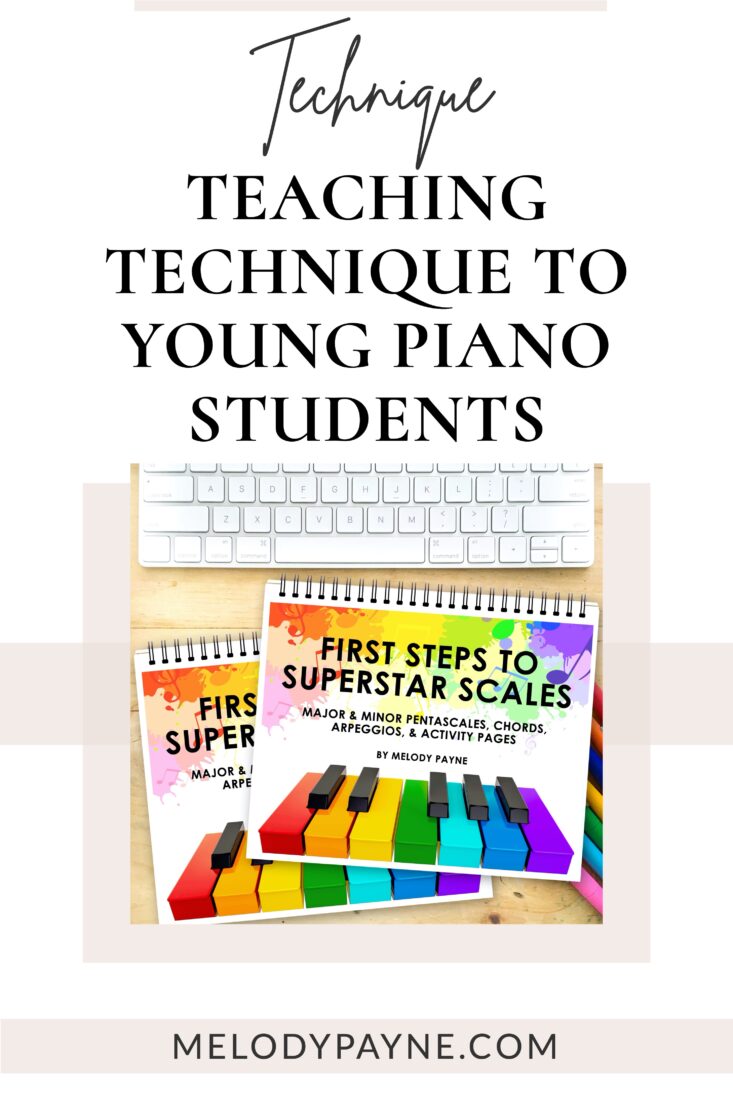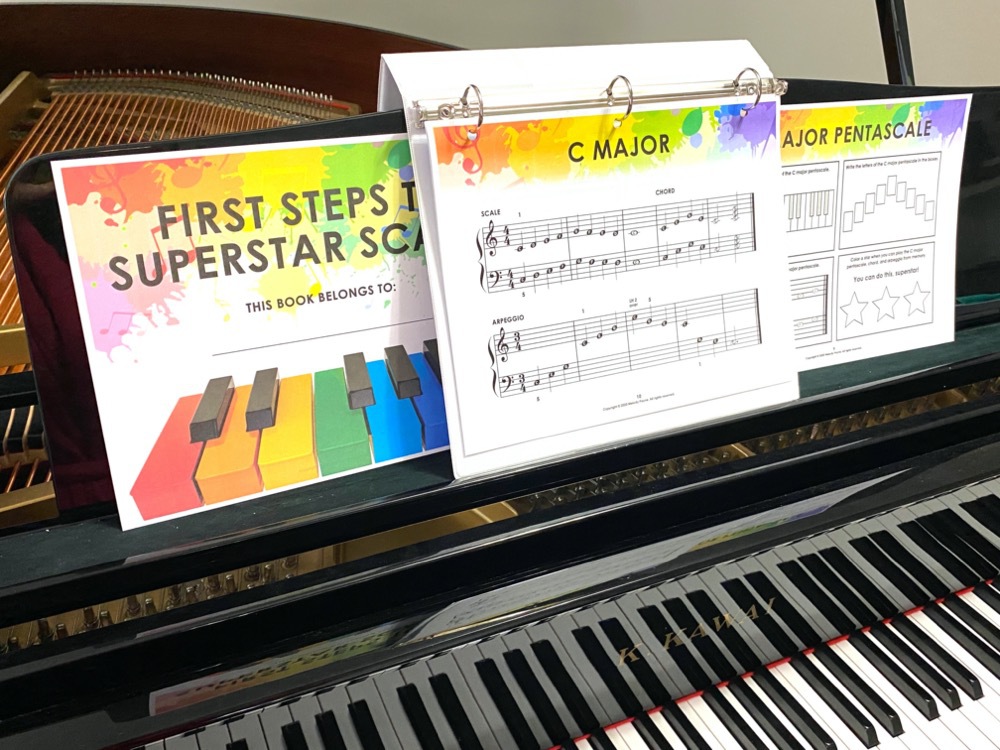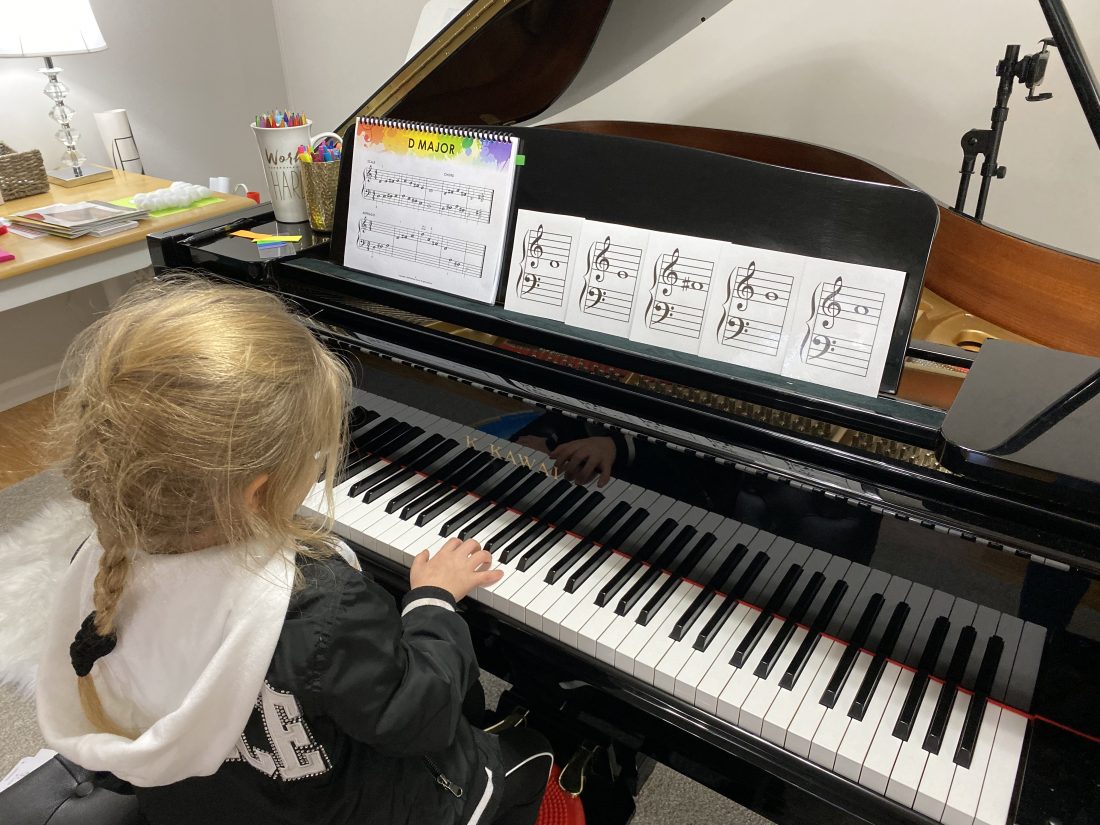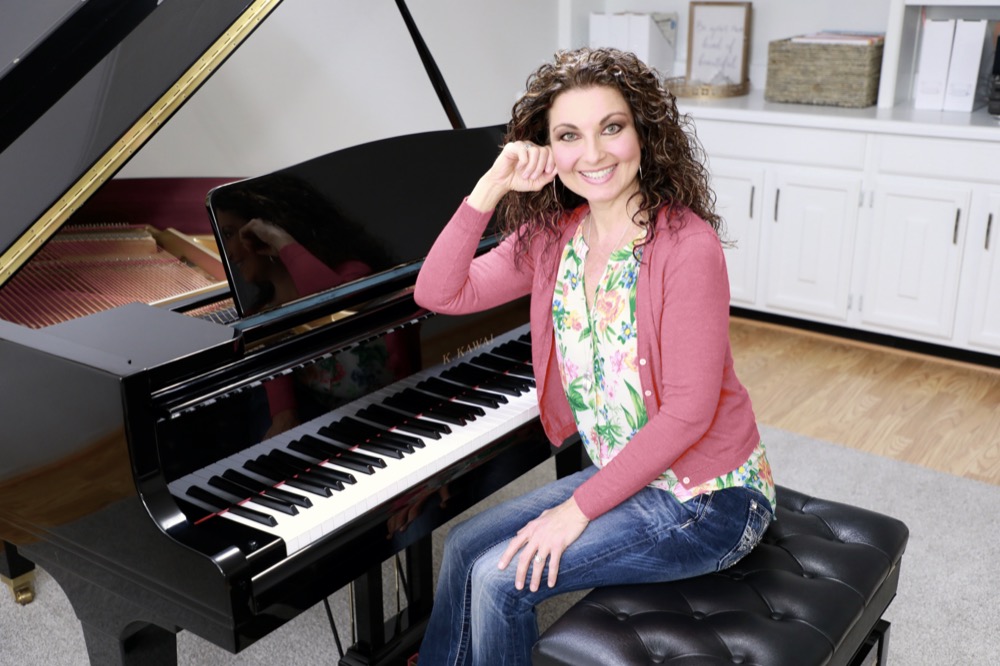Teaching Beginning Piano Scales to Young Piano Students
This post may contain affiliate links. If you purchase something through an affiliate link, I will receive a small commission at no cost to you. For more information, read the disclosure statement here.
Introduce your students to major and minor pentascales, chords, and arpeggios in a colorful and engaging way with this vibrant beginning piano technique book. The study of piano scales, chords, and arpeggios is extremely important to a pianist’s development. Help your students become Scales Superstars as they work their way through this valuable beginning piano scales book.

Remember the first time you went bowling?
Think back to your first bowling trip. You’re a really small child. You are so excited to go for the first time, and it’s your turn. The moment you’ve been waiting for! So you carry the huge bowling ball over to the bowling lane and give it a roll.
You quickly learn that it is so hard to roll the ball straight and knock over any pins because it keeps rolling into the gutter. Every. Single. Time.
Disappointing! Sad! Frustrating! No fun at all!
But you want to bowl! It looks like so much fun! Your older brother and sister are bowling, and your parents, and their friends, and having a wonderful time. But you are struggling because it’s too hard and a bit out of your reach.
So your parents ask the staff to put bumpers into the gutters.
And now it’s your turn again. In your mind, everything is on the line. It’s make-it-or-break-it time.
You heave the ball down the lane and wait, breathless.
The ball rolls into the bumper, and doesn’t go in the gutter! It bounces off the bumpers like a slow-motion pinball, and …….
Oh, the wait is excruciating …….
Success! A strike! With the bumpers in place, your ball isn’t rolling into the gutter anymore! You’re knocking down pins! Bowling is so much fun now, you’re scoring points, and you’re having a terrific time. All because you got the help you needed to be successful.
That’s exactly what First Steps to Superstar Scales does for beginning pianists, no matter the age or stage of learning. It’s a beginning piano technique book that provides the “bumpers” that students need until they are ready to “bowl” on their own.

This pentascales book was created especially for learners who:
- Are any age
- Aren’t reading on the entire grand staff yet
- Are visual learners
- Prefer to have a reference sheet
- May prefer or learn better through the printed page than through rote learning
What’s included?
- Simplified circle of fifths
- All major pentascales, cross-hand arpeggios, and broken & block chords
- All minor pentascales, cross-hand arpeggios, and broken & block chords
- Activity page to go along with each pentascale
- “This book belongs to” student page
- Teacher pages
- Introduction
- Helpful hints
- Printing and binding instructions
- Student certificate of completion
Terrific to teach and reinforce:
- Piano technique
- Scales
- Arpeggios
- Chords
- Proper hand & finger position
- Majors
- Minors
- Sharps and flats
- Music theory
- And so much more!

What is unique about this beginning piano technique book?
The study of piano scales, chords, and arpeggios is extremely important to a pianist’s development. Beginning students of all ages will become Pentascales Superstars as they work through this valuable beginning piano technique book of pentascales, broken & block chords, and cross-hand arpeggios in all major and minor keys.
It is written in large, friendly notation.
- “Helper notes” (also called “Alphanotes”, “notes with letters”, and “letter noteheads” are used throughout this book to guide students to the correct piano keys.
- This gets little ones playing on the staff quickly and makes them feel “big” because they are “reading” the notes on the staff just like the “big kids”.
- And it helps older learners feel confident from the very beginning. This is so motivating for any age!
There are no key signatures.
- This book is meant to be used early in a student’s study, before key signatures are introduced.
- Accidentals are written within the pentascales, chords, and arpeggios.
- This is a wonderful way to help students remember which finger plays a black key, or which note is a black key.
This book includes an activity page for every key and introduces and reviews the pentascales in multiple ways.
- Coloring the correct piano keys of the pentascale
- Naming/spelling the letters of the pentascales
- Tracing the pentascales on the staff
- Memorizing each pentascale, chord, and arpeggio
Teaching each item can be done in a variety of ways.
- By rote
- By discovery (my favorite way)
- Directly from the book, etc.

The colorful pages in First Steps to Superstar Scales are especially great for visual learning styles. These sheets can be used on your iPad or other tablet, you can use them without binding them like in the photo above, you can print and bind them for student use, or 3-hole punch and put in your student’s binder like you can see in the photo below.
Why do I like my beginning students to do similar things as my more advanced students?
- Because of the hierarchical learning principles of Bloom’s Taxonomy
- To develop higher order thinking skills from the beginning
- To create an environment of highly personalized learning
- To fully prepare them to play octave scales and arpeggios, chord progressions, lead sheets, and a variety of other musical elements and styles
A few helpful hints:
Even with my youngest students, I refer to each item (pentascale, chord, arpeggio) with the correct name from the beginning, and I’ll give a nickname at times along with the correct name to help my student remember how to play it. They love the “cartwheel arpeggio”/“arpeggio cartwheel”. I even have them do a cartwheel in the studio to help drive the point home!
Sometimes students will mix up the names of each item (pentascale, chord, arpeggio) or not remember them at all, so the names are also included on every pentascale page for reference and review.
I want my beginning students to be comfortable and confident moving around the piano keys into different “hand positions”, and I don’t want them to feel like they are stuck in a single position. (C position, Middle C position, etc.). I don’t want them to think the piano key E is a “3”.
Printing and binding options:
- Print the pages you need for each student front/back – Print a test page first, and be sure your printer is set to “short binding” so the pages print in the same direction front and back.
- Print the Circle of 5ths page as your first front/back page, and the A-flat minor as your last front/back page. Your printed book should look just like it does in the video so the activity page and pentascale page of each key are visible when the book is open.
- Then print each individual page that you want to include in your student books: Cover page, “this book belongs to” page, certificate, etc.
- **HINT: you can click and drag the pages within the thumbnails of the PDF to put them in the order you need!
- Cheapest option: Print each key as you need it, hole punch, and add to your student’s binder. Simple, cheap, and perfect. It’s easy to turn the binder sideways and fold the cover back so it’s out of the way, just like in the photo below.
- Another option: If you have a binding machine, print double-sided and bind for each student. This is what I do, and what you see in the video.
- Easiest option: Have the book printed and bound at a local office supplies store. This may be more expensive, but it is probably the easiest option overall.
- Pricing on each option will vary.

Recommendations:
Here are my favorite recommendations for a binding machine, binding spines, laminator, laminating sheets, and 3-hole punch. These tools have made my life so much easier! And more fun! 😀 And they’re the best tools for putting together the perfect beginning piano technique books for your students.
- Bostitch 3-hole punch: The best 3-hole punch I have ever owned.
- Swingline Laminator: Does an excellent job! Really – it’s absolutely fantastic and I love it.
- Apache laminating pouches: Work perfectly with the Swingline laminator, and I much prefer these pouches over the Swingline pouches.
- Swingline Binding System: What I use to bind printable books & worksheets for my piano students
- REUSABLE binding spines: These are my favorite! If I need to add pages to a student workbook that I’ve made, it’s really easy to open the spines, add the pages I need, and close them.
What do students do next?
- After my beginners finish the First Steps to Superstar Scales book, they are ready to move on to other technique books.
- If your students aren’t quite ready for octaves scales and chord progressions in the Superstar Scales book, the Junior Superstar Scales book is the perfect next step!
- The Superstar Scales piano technique book includes octave scales, octave arpeggios, and I-IV-I-V7-I chord progressions for students who are ready to take the next big step!

Coordinating flash cards:
I also use flash cards (a set that includes sharp and flat notes as well as no accidentals) to help my students learn scales & chords. Read more here and buy the flash cards here. The set includes full-page flash cards that are perfect for screen-sharing during online piano lessons.

Here’s what teachers are saying:
More blog posts about teaching beginning piano
- 9 Essentials to Include in a First Piano Lesson
- Easy Composition Activity for Beginning Piano Students
- 5 Tips for Engaging Young Piano Students During Online Lessons
Don't miss out!
Follow on Facebook and Instagram, join the best Facebook group for piano teachers, and subscribe to the newsletter to get helpful teaching tips, resources, and tutorials delivered straight to your inbox every week.
Melody Payne
Melody Payne
Welcome!

Hi! I’m Melody Payne, a pianist and piano teacher, educational resource author, a fun-loving wife to the most wonderful and talented hubby I could ask for, and a lifelong learner who loves to share. I want to make your life as a music teacher easier by writing and sharing helpful and relevant music teaching articles, and by creating educational resources with your very own students in mind. If you are a parent who wants to enroll your child in piano lessons, I’d love for us to get started building those skills that can give your child a lifetime of musical enjoyment!




This Post Has 4 Comments
Hi everyone, what a great resource! I’m just wondering what the difference between first steps and junior pentascales are if there are any? I am learning piano to hopefully become a piano tutor one day, so am all new to this, so please excuse my newness!
Hi Kitty, welcome to piano teaching! First Steps to Superstar Scales, Book 1 in the Superstar Scales series, includes on-staff pentascales, broken & block chords, and cross-hand arpeggios in all major and minor keys. Helper letters in each note head, plus accidentals, guide your beginning pianists to the correct piano keys. An activity page for each scale helps beginners learn the letters and shape of each scale in multiple ways. Learning is reinforced through coloring the piano keys of each pentascale, writing the letters of each pentascale, tracing the notes of each pentascale, and coloring a star when each scale, chord, and arpeggio is learned.
Junior Superstar Scales, Book 2 in the Superstar Scales series, includes on-staff pentascales without helper letters, broken & block chords, I-V-I and I-V7-I beginning chord progressions, and cross-hand arpeggios in all major and minor keys, with key signatures, in an engaging and easy-to-read format. Learning is reinforced through coloring the piano keys of each pentascale, writing the letters of each pentascale, and coloring a star when each pentascale, chord progression, and arpeggio is learned. For more information on each book, plus videos for a peek inside each book, please visit https://melodypayne.com/superstar ⭐️
Hi Melody! I am so interested in these and am trying to figure out how to make the landscape orientation work. My students have a binder for all their music; do you just put these landscape oriented pages in the binder “sideways”? I don’t really want to bind a new book individually so I’m trying to figure out what would make the most sense!
Hi Whitney! Thanks so much! For my youngest local students, I usually bind the pages of First Steps with my binding machine, but that’s absolutely not required. For my online students, I ask their parents to print the pages, and some of them keep the individual page we’re working on in the inside pocket of their binder so they can grab it and put it on the piano quickly and easily when they’re practicing. Many of the parents 3-hole punch the pages and put them in their child’s binder “sideways”, and rotate their binders and fold the cover back so it’s out of the way. The little ones especially love working out of a sideways binder because it feels like they’re getting away with something 🙂 Hope this helps, and have a wonderful week!